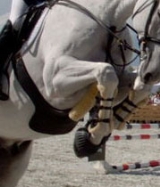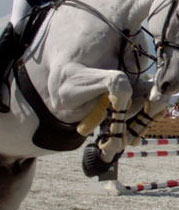
Bell boots
Encyclopedia

Horse
The horse is one of two extant subspecies of Equus ferus, or the wild horse. It is a single-hooved mammal belonging to the taxonomic family Equidae. The horse has evolved over the past 45 to 55 million years from a small multi-toed creature into the large, single-toed animal of today...
. They encircle the horse's ankle, and protect the back of the pastern
Pastern
The pastern is a part of the leg of a horse between the fetlock and the top of the hoof. It incorporates the long pastern bone and the short pastern bone , which are held together by two sets of paired ligaments to form the pastern joint...
and the heels of the animal.
Uses of Bell Boots
Bell boots are usually worn to prevent overreaching (when the horse "grabs" his front heels with the toes of his back feet, resulting in injury), or if the horse is wearing shoe studsShoe studs
Shoe studs may refer to:*Caulkin or calks on a horseshoe*Cleat on a human shoe*The sole studs of Caulk boots, which are similar to cleats....
, to protect him from accidentally injuring himself with the stud of the opposing hoof. In some cases a horse with corrective or poor shoeing wears shoes that protrude behind the foot, making it easier for a horse to overreach and spring or completely pull off the shoe. This is most commonly seen when the horse is jumping, working in mud or on a slippery surface, running cross-country, or longeing
Longeing
Longeing or lungeing is a technique for training horses, where a horse is asked to work at the end of a long line and respond to commands from a handler on the ground who holds the line. It is also a critical component of the sport of equestrian vaulting...
, and bell boots can help prevent this from occurring. Bell boots are occasionally worn when shipping a horse, if the bandages or boots used do not provide protection to the heel region, or if a horse tends to pull his front shoes by stepping on them with his back feet. Bell boots are also sometimes used when the horse is turned out, for extra protection or to help prevent him from accidentally pulling a shoe if he is especially exuberant while playing.
Applying Bell Boots
Bell boots are usually made of rubber. They may be open, with Velcro or other fastenings to close them, or closed and slipped on over the hoof. Although open bell boots are the easiest to apply, close bell boots are more secure as they have no chance of slipping off.To apply closed bell boots, it is easiest to turn them inside out, before slipping them over the toe of the foot. It may also help to place them in warm water so they will expand before trying to put them on.
A correctly-sized bell boot should just touch the ground behind the bulbs of the heel while the horse is standing. The mouth of the bell boot should be just loose enough to fit a finger or two between it and the horse's pastern.

